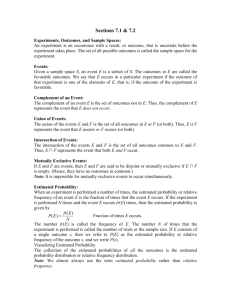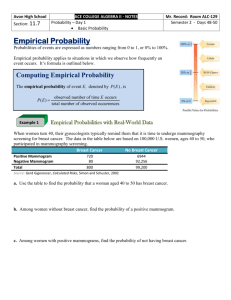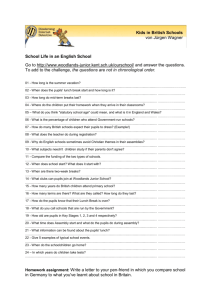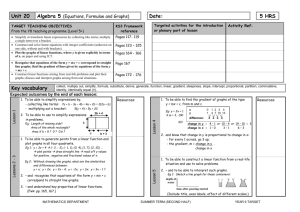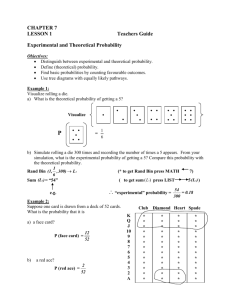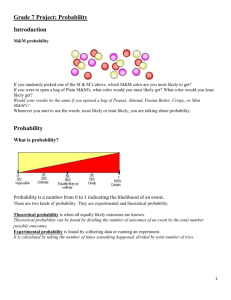Lesson 11 Probability
advertisement
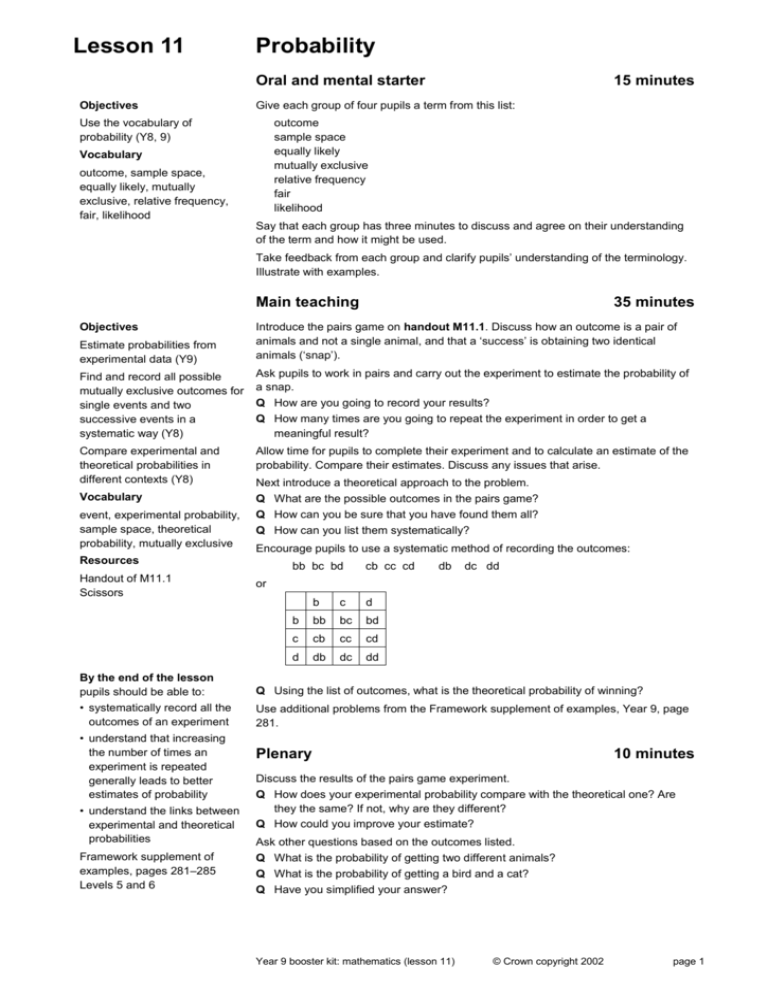
Lesson 11 Probability Oral and mental starter Objectives 15 minutes Give each group of four pupils a term from this list: Use the vocabulary of probability (Y8, 9) outcome sample space equally likely mutually exclusive relative frequency fair likelihood Vocabulary outcome, sample space, equally likely, mutually exclusive, relative frequency, fair, likelihood Say that each group has three minutes to discuss and agree on their understanding of the term and how it might be used. Take feedback from each group and clarify pupils’ understanding of the terminology. Illustrate with examples. Main teaching Objectives Estimate probabilities from experimental data (Y9) 35 minutes Introduce the pairs game on handout M11.1. Discuss how an outcome is a pair of animals and not a single animal, and that a ‘success’ is obtaining two identical animals (‘snap’). Find and record all possible mutually exclusive outcomes for single events and two successive events in a systematic way (Y8) Ask pupils to work in pairs and carry out the experiment to estimate the probability of a snap. Q How are you going to record your results? Compare experimental and theoretical probabilities in different contexts (Y8) Allow time for pupils to complete their experiment and to calculate an estimate of the probability. Compare their estimates. Discuss any issues that arise. Vocabulary event, experimental probability, sample space, theoretical probability, mutually exclusive Q How many times are you going to repeat the experiment in order to get a meaningful result? Next introduce a theoretical approach to the problem. Q What are the possible outcomes in the pairs game? Q How can you be sure that you have found them all? Q How can you list them systematically? Encourage pupils to use a systematic method of recording the outcomes: Resources Handout of M11.1 Scissors bb bc bd cb cc cd db dc dd or b c d b bb bc bd c cb cc cd d db dc dd By the end of the lesson pupils should be able to: Q Using the list of outcomes, what is the theoretical probability of winning? • systematically record all the outcomes of an experiment Use additional problems from the Framework supplement of examples, Year 9, page 281. • understand that increasing the number of times an experiment is repeated generally leads to better estimates of probability • understand the links between experimental and theoretical probabilities Framework supplement of examples, pages 281–285 Levels 5 and 6 Plenary 10 minutes Discuss the results of the pairs game experiment. Q How does your experimental probability compare with the theoretical one? Are they the same? If not, why are they different? Q How could you improve your estimate? Ask other questions based on the outcomes listed. Q What is the probability of getting two different animals? Q What is the probability of getting a bird and a cat? Q Have you simplified your answer? Year 9 booster kit: mathematics (lesson 11) © Crown copyright 2002 page 1 Pairs game M11.1 A child’s game has two windows. In each window, one of three different animals – a bird, cat or dog – is equally likely to appear. When both windows show the same animal, the child shouts ‘snap’ (this counts as a ‘success’). Estimate the probability of getting a ‘snap’, like this. • Cut out the three animal cards, place them face down and shuffle them. • Pick a card. This represents the animal that appears in window 1. • Replace the card, face down. Shuffle the cards again. • Pick a card. This represents the animal that appears in window 2. Decide how to record this result. Decide how many times you are going to repeat this process. Use your results to work out the probability of getting two animals the same. Year 9 booster kit: mathematics (lesson 11) © Crown copyright 2002 page 2

![afl_mat[1]](http://s2.studylib.net/store/data/005387843_1-8371eaaba182de7da429cb4369cd28fc-300x300.png)
